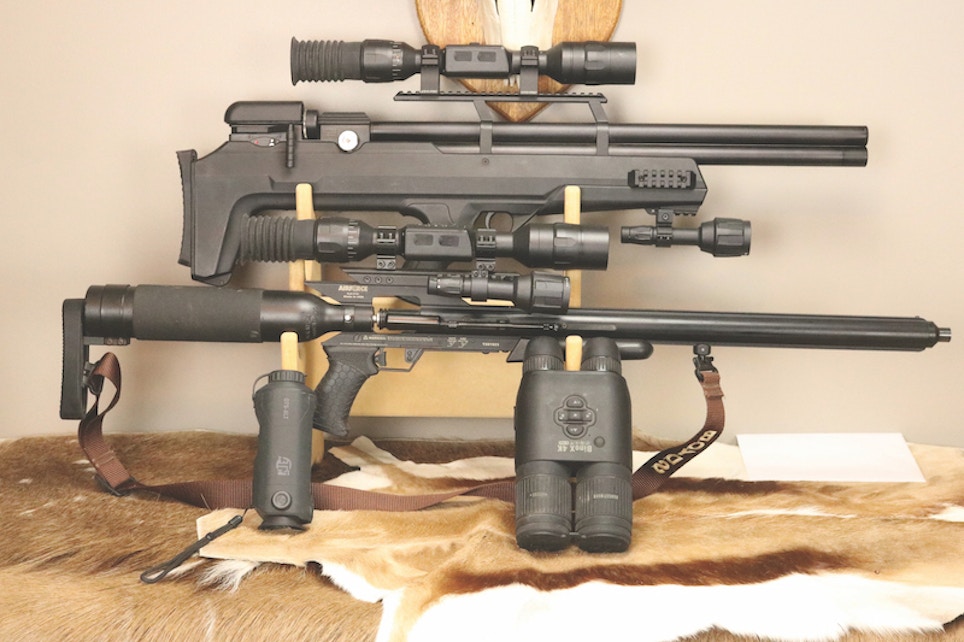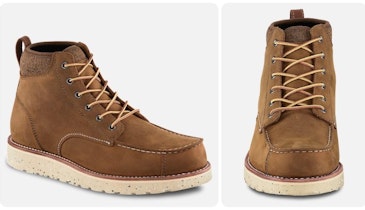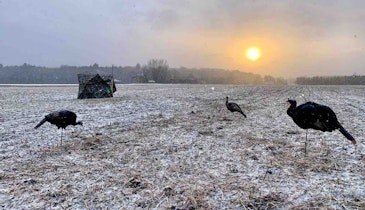
Part of the author’s nighttime artillery: The ATN X-Sight LTV 5-15X digital scope mounted on the Air Venturi Avenger (top) and .308 AirForce Texan along with the OTS-XLT thermal monocular and the Bino X 4K NV binocular below.
There are many hunting applications well suited to the use of airguns. As a rule, these guns are very accurate and quiet compared to firearms. And while they have much lower power are still capable of effectively anchoring your quarry. Today’s pre-charged pneumatic (PPC) air rifles are available in calibers ranging from .177 to .72, with many featuring adjustable power settings. They can be used for pest control, predator hunting or even taking larger animals such as wild hogs. And I have found them to be useful for hunting at night, especially in situations requiring some degree of stealth.
Whether for pest control, such as shooting raccoons in the barn, hunting coyotes at night or eliminating feral hogs that are tearing up a golf course, the fact that airguns are quiet and allow for precise shot placement make them a great option. A moderately powerful .30-caliber air rifle can dump a hog with a well-placed head shot at 50 yards and will sound like a muffled “pop” that would go unnoticed in most suburbs.
It’s this stealth mode that I find so useful for hunting the suburban hobby farms near my house. I have the landowner’s permission to hunt coyotes and it is legal to do so, but if I discharge a firearm in the area someone will surely call the police. It’s happened to me in the past, and every time it has been resolved, but it’s also blown my hunt on each occasion. It’s enough of a hassle that I quit hunting these areas with a firearm. But using an air rifle I’ve shot coyotes with housing developments in close proximity and have never been detected. And the fact that the power and carrying range of these guns is limited makes them far safer to shoot in these areas.
Right Gun for the Right Job
The guns I use depend on the targeted species and the situation. For example, I frequently use the Air Venturi Avenger for small- to medium-size quarry. The Kalibrgun Cricket II Tactical is my urban hunting gun used for coyotes and wild hogs when it’s necessary to be quiet. And the gun I use for hog and predators when the ranges might be longer and a low sound signature is not required, is the AirForce Texan .308.
The Air Venturi Avenger is a regulated .25-caliber bullpup design, with sidelever cocking, eight-shot rotary magazine and a fully shrouded barrel. At 50 yards, it can drop pellets into a single hole all day long and do so very quietly. The gun is configured with several Picatinny rails for mounting accessories. I have an ATN X-Sight 4K 5-15X IR night vision scope mounted on UTG high-profile rings, with an IR illuminator mounted under the forend. With tack driver accuracy, adjustable power output, a high shot count and fast-cycling action, this rig is perfect for taking out rats around the feedlot or raccoons in the barn. But it is also capable of reaching out for nighttime rabbits on the golf course at longer range.
When going after predators or hogs in areas that are noise sensitive, or where there is a need to limit the carrying range of the projectile, my gun of choice is a KalibrGun Cricket II Tactical PCP. This is a .30-caliber bullpup that I pair with JSB Exact Diabolo pellets when hunting at closer range in more built-up areas, or the NSP airgun slug if more penetration is required or when longer distance shooting is anticipated. This bottle forward bullpup is a powerhouse and is extremely accurate with either the pellets or slugs. The sidelever cocking mechanism (my preferred action) is smooth and fast to cycle, reliably auto indexing a 10-shot rotary magazine. I use this rifle more in daylight hours than for night hunting, so rather than mounting a night vision scope, I’ve opted for a standard MTC King Cobra first focal plane scope. When moving into a nighttime shooting situation, a OneLeaf NV-100 IR monocle is mounted to provide night vision capabilities to the standard scope.
When going after larger quarry at night, my gun of choice is the AirForce Texan in .308. This is a compact and lightweight bottle-for-a-buttstock design, with a pistol grip and adjustable forend. This rifle is a very powerful, flat shooting, single shot designed to work with heavy slugs. There are several configurations (and calibers) available, including rifle or carbine versions that can be equipped with a suppressor. There is a healthy selection of aftermarket accessories that allow for individualized setup of the rig. My Texan is a carbine, and while I have a suppressor for it, I generally don’t use it. This is my gun for reaching out and hitting hard; it’s mostly used in the wide-open spaces hunting predators or hogs. I have another ATN X-Sight 4K Pro IR night vision scope mounted on this gun, and usually mount the IR illuminator on a side rail next to the scope.

Night Vision Optics
I mentioned that the low sound signature and limited carrying range of airguns make them a great candidate for stealthy night hunting. But there is another consideration to keep in mind: Besides the sound signature, the biggest challenge when attempting to remain stealthy is target acquisition in low light or darkness. I was culling raccoons at a local farm a couple years ago using a visible light and a complaint was called in saying there was somebody (me) with a red spotlight sweeping the fields. I guess they thought it was either a poacher or thief trying to break into the outbuildings. The result was that I had to provide the police with proof of permission to hunt the property and wait around for almost an hour while they confirmed my permission and that discharge of a firearm (or air rifle) within city limits was legal. The issue was resolved in my favor, but the hunt was blown. The take-away is that if you want to be truly stealthy, visible lights are probably not the best approach. I will say that if stealth is not an issue, handheld or gun-mounted lights work just fine.
When discussing my hunting rigs, you might have noted that I’ve gravitated toward night vision optics. After years of trial and error, ATN has become my go-to night vision solution, and I use the X-Sight LTV 5-15X digital scope on several rifles. These scopes are day/night capable, but if I am going to use the gun primarily in the daylight, I still prefer a standard scope. The reason I like the X-Sight digital scope is that the image quality in night vision mode is very good and they are intuitive to use. User interface is easy to operate in the dark, the video quality is good, they provide one-shot zeroing and the battery life is exceptional.
I’ve also been using the ATN ThOR 4 Smart HD thermal riflescope for hunting feral hogs with big-bore airguns and find it very effective when targeting these porkers in open areas. I do find that when there is a lot of brush or structure, especially those that retain heat, I have an easier time picking up my target with IR night vision. I also like the fact that it is often easier to make a precise shot with an IR night vision scope because more detailed information is visualized. I think this is more of an issue for airgun hunters because it is necessary to place the projectile exactly on target to generate a clean kill.
More recently I started carrying the OneLeaf NV-100 IR monocle, which is a relatively inexpensive device that can be mounted on most scopes as a backup. The device comes with collars and a mount that slip over the eyepiece of a standard scope and locks down with a small set screw. It is easy to set up, and the night vision is acceptable. It is not the quality of a purpose designed NV device but is fine for carrying in your hunting pack to use when a day hunt drifts into the nighttime hours. While I use this for a backup, if your budget is constrained, it could be a game changer for your nighttime airgun hunts.

Ancillary Optics
The last topic to touch on is the ancillary optics I use for nighttime hunting. Most of the shots I take at night, regardless of species being targeted or guns being used, occur from 20 to 70 yards. When hunting predators, the calling techniques used are the same as when shooting a powder burner, though you might try to coax a coyote in a bit closer for the shot. In the past, I’d scan for incomings with a red spotlight (I use the Coyote Light), acquire the lit-up predator in my scope, then take the shot. This involved sweeping the spotlight, and once the incoming critter was spotted turning off the light and acquiring the target in the IR night vision scope for the shot. Lately I’ve been sweeping the area with an IR binocular, the ATN Bino X 4K at low magnification, then switching over to the night vision scope once the incoming target is located.
A couple months ago, I picked up the ATN OTS-XLT thermal monocular and really like this device for scanning smaller areas, looking for rats in the barn or a raccoon up in a row of trees. It allows a very quick identification of potential targets. While I like using thermal imaging to scan an area, this is not very effective using a monocle. However, I recently had a chance to use a buddy’s thermal binocular, and this seems like a great approach that I’d like to get a bit more experience with.
It’s been said that if you want to have success hunting, you need to be in the right place at the right time. For the pest and varmint species many airgunners target, this means being out at night. Selecting the right nighttime optics for your air rifle will provide an effective and stealthy hunting tool. The low sound signature, inherent accuracy and constrained power profile of airguns can open areas for hunters where a firearm is not an option.





